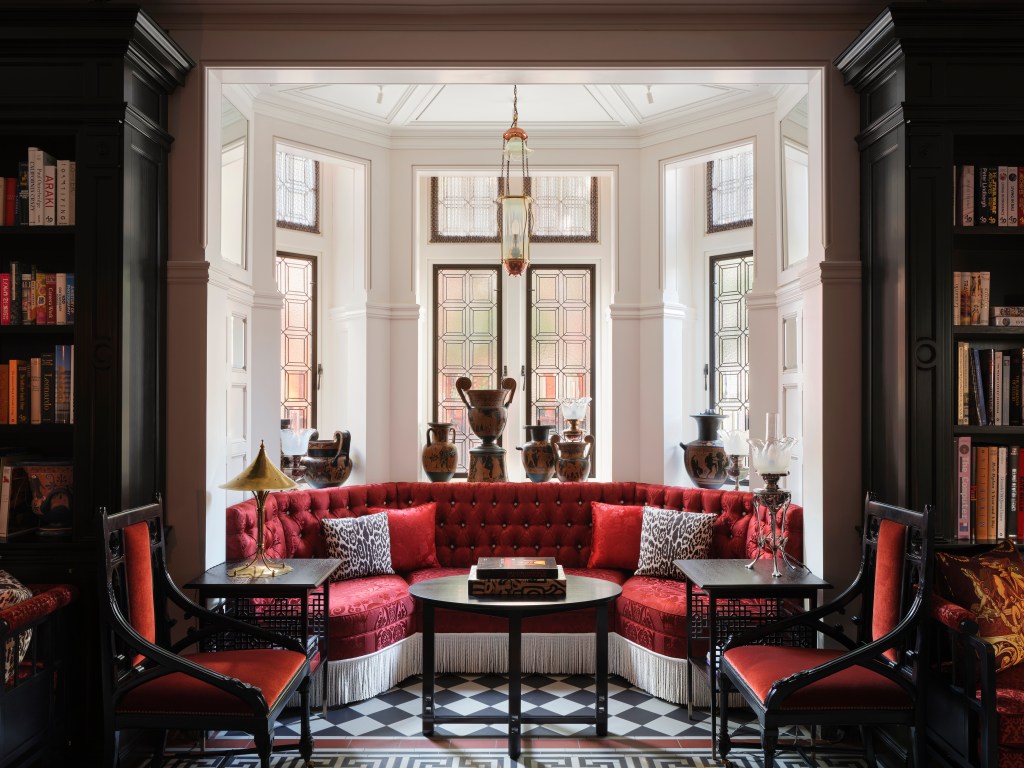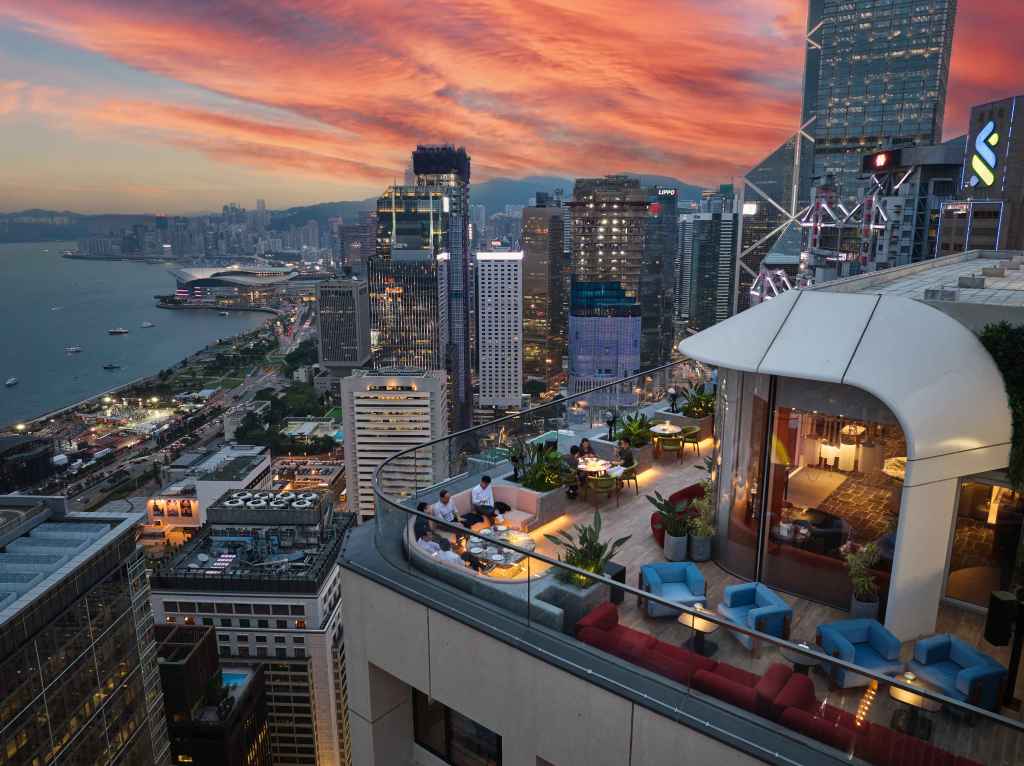François-Joseph Graf can conjure a universe from the ground up, which he’s just done on a tree-lined street a few steps from Sloane Square.
His interiors for the new hotel, At Sloane, are a ticket back to the age of Arts and Crafts, when designers cast off the clunky shackles of Victorian design and embraced the sensual colors and patterns of nature with a lightness of touch.
So precise was Graf’s vision for At Sloane that he chose every replica of Greek and Chinese vase — there are hundreds of them on display here — and called in Ateliers Loire, the storied stained glassmaker in Chartres, France, to create the window panes of the six-floor hotel, a co-production of Cadogan Estates, hotelier Jean-Louis Costes and Graf.
So evocative are these interiors, it’s easy to imagine Virginia Woolf reading in the large bay window seat that faces Sloane Gardens, or William Morris having a cup of tea at the newspaper-strewn dining room table that doubles as the hotel’s front desk.

At Sloane was an unusual project for Graf, an architect, interior designer, collector and expert on late 19th and early 20th century decorative arts, who is more accustomed to working for private clients.
Graf redid Valentino Garavani’s Holland Park home in London; created multiple interiors for the Kravis family, and has redecorated airplanes, yachts and lakeside villas for tycoons and aristocrats around the world.
His passion for interiors was born when he was a child traveling with his family. He would later study at the Ecole des Beaux-Arts and the Ecole du Louvre and then take the job of his life, working at the Palace of Versailles with Pierre Verlet, formerly the museum’s head curator.
On the job, “something extraordinary happened, and I had the key to the castle in my pocket,” says Graf, who is sitting in the At Sloane lobby’s curving window seat, which is covered in claret silk brocade. “I loved walking around there — alone — with the shutters closed and followed by ghosts, invisible people, running on the parquet — it was really very exciting.”
At Sloane is only his second hotel — the first was La Mirande in Avignon, which he did more than 30 years ago. Unlike a private home, the hotel offered him the opportunity to reinvent an entire world inside the building at 1 Sloane Gardens.

The building, which was once filled with mansion apartments, was gutted and rebuilt by ReardonSmith Architects. They created 30 bedrooms and suites; a lobby on the ground floor; a bar with a separate entrance downstairs, and a restaurant on the new sixth floor, which has its own cupola and offers views over Sloane Square and beyond.
It was the red brick and white stucco facade of the building — which was built in 1889 by Edwin Thomas Hall, the British architect who also designed the Tudor Revival Liberty store in Soho — that set Graf on his path.
“The inside of a building should smell and breathe the same air as the outside. Otherwise, the interiors just become ‘decor.’ When you step inside you have to have to feel that the house is alive. The idea here was to give the impression that everything already existed.”
Instead, it was all new.
“We built everything — the floors, the ceilings, the stained glass. I put stained glass everywhere — in the bar downstairs, the lobby, the restaurant and the rooms because it’s so cozy, so English. It means you don’t have to use those chiffon curtains, which are terrible,” Graf says.

He focused specifically on Arts and Crafts because the period “was so imaginative, so inventive. The earlier Victorian period was all heavy mahogany” by contrast, Graf says.
To illustrate that point, he pulls up a picture of a sleek black commode made in 1866 by E.W. Godwin, the English architect-designer whose creations were angular, linear — and radical for their time.
Graf, who’s dressed in a blue striped shirt, silk tie, navy shacket and half-frame glasses, chose everything for the hotel: the colored glass; books; lamps, and repro Greek or Chinese vases clustered on top of the lobby’s library, or stacked into the bookcases of the chic, black, white and russet dining room.
Like a painter, Graf used a palette of colors and textures to achieve the right mood in each room. There are 21 carpet designs, 19 curtain designs and 50 custom made fabrics, from companies including Loro Piana.
Although the bedrooms are seemingly less colorful than the lobby and bar, they are filled with a rainbow of muted shades.
What looks like a cozy white suite is actually filled with 25 colors, multiple shades of beige “and a little pale red. Red is very cheerful,” says Graf, adding the carpets in some of those rooms are made from six different shades of beige and off-white.

He’s obsessed with lighting and installed more than 700 lamps, spots, chandeliers and sconces across the hotel. Some of them are original W.A.S. Benson Arts and Crafts lamps, while others are reproductions. There is also a sprinkling of tiny, recessed spotlights of Graf’s own design that cast a warm, gentle aura over the room.
“Light is the most important thing” in interior design, he says. “It’s better not to spend one penny on the walls and to have the proper light. It’s better to buy sconces and a great chandelier than to decorate all around. If you decorate nicely with average light, everything will collapse.”
Those spotlights are for the public areas only.
Graf points out there are none in the bedrooms, bathrooms or toilets. He says it drives him nuts when he’s taking a bath at a hotel, looks up at the ceiling and sees spotlights.
“Why would you want spotlights in your eyes?” asks Graf, who has stayed in luxury hotels worldwide and has a lot to say about how they — and their in-house restaurants — are designed and managed.
The restaurant he designed on the sixth floor is inspired by the Peacock Room, created in 1876 by James McNeill Whistler and Thomas Jeckyll. (The original was eventually relocated to the Smithsonian’s Freer Gallery of Art in Washington, D.C.).
The restaurant’s cupola has an octagonal space fit for one table, and even more gorgeous views across Chelsea.
Graf worked closely with Costes on all aspects of the interior and says the Parisian hotelier is as detail-orientated and stubborn as he is.
Costes, he says with a smile, is “a genius, a very nice guy and it’s easy to create things with him, although it’s not too easy to work with him. He trusts you and he gives you ideas. He also knows what the table heights should be and he did the layout for the restaurant. He has a great attention to detail,” Graf says.

Hugh Seaborn, chief executive officer at Cadogan, says it’s “a joy to see so much of Chelsea’s architecture and heritage reflected and celebrated” throughout the hotel. “We have been working closely as a team for six years to realize [Costes’ and Graf’s] exquisite vision for their first London property, and it is inspiring to see the artisanship involved at every stage.”
Although At Sloane is only his second hotel, Graf knew exactly how he wanted guests to feel as soon as they stepped through the door.
“You create a dream for three or four nights, you surprise people with the design, and you give them pleasure. I would love to do more hotels,” says Graf, whose ambition is to redo a “grand hotel in London” with intimate, sensual interiors similar to those at At Sloane.
Graf says he likes the idea of transforming the historic, luxury architecture of grand hotels and designing something that appeals to a new-generation clientele. His ambition is always to create an atmosphere that speaks to good taste, rather than loads of money, a space that “gives people the idea they’ve been invited.”
Graf’s own home in Paris is filled with historical furniture, objects and, of course, good lighting. He fantasizes, he says, about living in a white box of a room with a rotating series of objects that he can focus on, and enjoy, for a short period of time.
“I’m dreaming of a room with nothing, just a bed and one piece that I could change according to my mood — every hour, every day, or every week,” Graf says.
Because even masters of the universe need to rest their eyes, and their senses, now and again.



